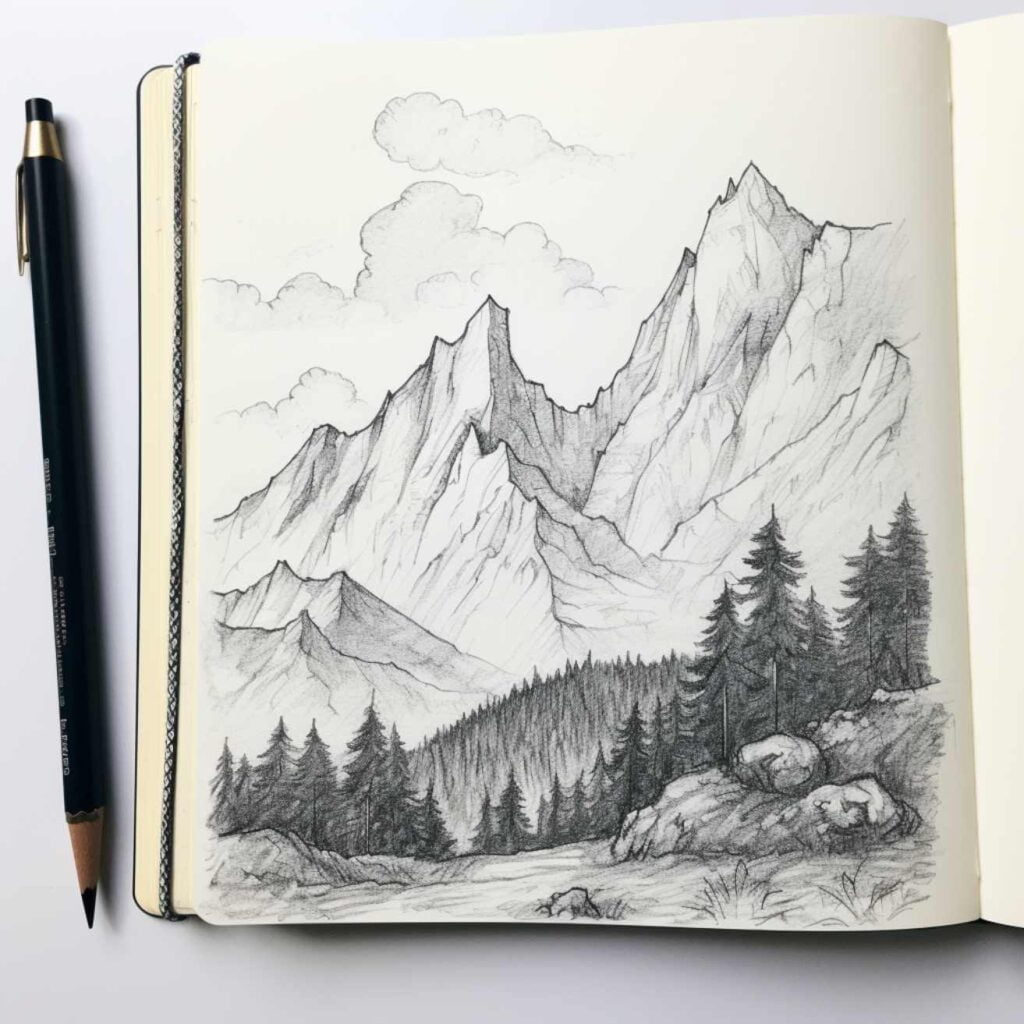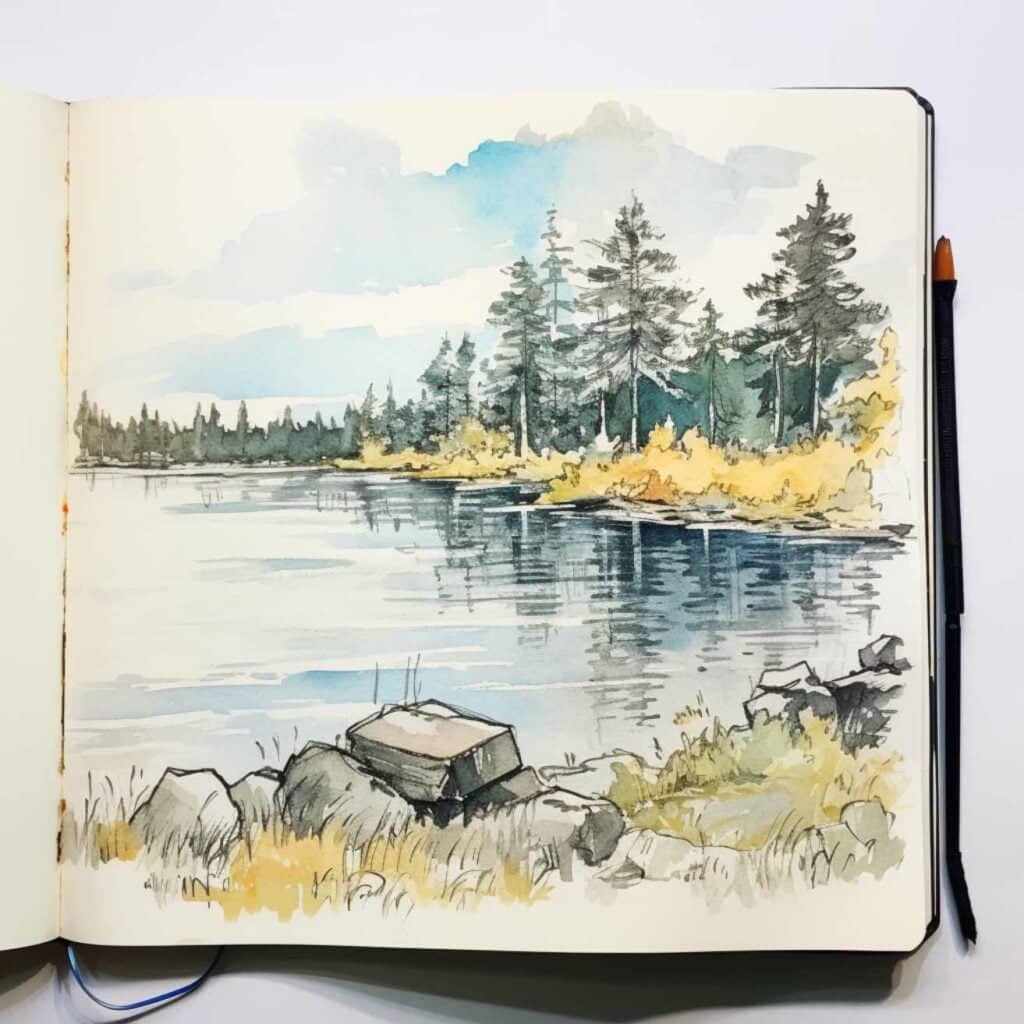Last Updated on November 29, 2023 by Dee
Looking for inspiration in landscape drawing? This article offers 25 creative ideas to spark your imagination. From peaceful beaches to majestic mountains, these ideas cater to artists of all levels, helping you to capture the beauty of nature in your drawings. Whether you’re a beginner or an experienced artist, there’s something here for everyone. Plus, don’t forget to check out the free landscape drawing templates available at the end of this article – they’re great for getting started on your next artistic project!
Table of Contents
25 Landscape Drawing Ideas
Are you looking for inspiration for your next landscape drawing?
Here are 25 landscape drawing ideas to get you started:
**This page may contain affiliate links to products I have used or recommend. If you purchase something from this page, I may receive a small percentage of the sale at no extra cost to you.**
Mountains

Draw a majestic mountain range with peaks and valleys using a variety of mark making in pencil.
Beach

Draw a sandy beach landscape with waves crashing on the shore in the middle ground. Here I have used my favorite black pens and color markers.
Forest

Draw a dense forest with tall trees and small details in the underbrush.
Waterfall

Draw a waterfall with cascading water and rocks.
Desert

Draw a vast desert landscape scene with sand dunes and cacti. Here I have used pencil.
Cityscape

Draw a skyline of a city with buildings and skyscrapers. I like to use a 6B Pencil or my Pitt Pens to get clean lines and fine details.
Countryside

Draw a peaceful countryside with rolling hills and farmland.
Lake

Draw a serene lake with reflections of the surrounding landscape.
Garden

Draw a beautiful garden with flowers and plants.
Seaside

Draw a seaside landscape with a lighthouse and boats.
Winter Scene

Draw a winter wonderland with snow-covered trees and a frozen lake. Here I have used pencil.
Tropical Island

Draw a tropical island with palm trees and clear blue water.
Sunset

Draw a stunning sunset with warm colors and a silhouetted landscape. In this example I have used Pitt Pens to outline my forms and give the artwork a “graphical feeling”.
Vineyard

Draw a vineyard with rows of grapevines and a charming farmhouse. Here I have used pencil.
River

Draw a winding river with rocks and trees along the banks.
Canyon

Draw a deep canyon with rugged cliffs and a winding river. I use these pencils.
Farm

Draw a farm with barns, animals, and fields.
Park

Draw a park with walking paths, benches, and trees using 2B, & 8B pencils.
Ruins

Draw ancient ruins with crumbling walls and overgrown vegetation.
Volcano

Draw a volcano with smoke and lava flowing down the sides.
Industrial

Draw an industrial landscape with factories and smokestacks. Here I used black fine liners and a watercolor wash.
Space

Draw a space landscape with planets and stars.
Underwater

Draw an underwater landscape with coral and sea creatures.
Fantasy

Draw a landscape from your imagination with dragons and castles.
Road Trip

Draw a pen landscape from a road trip with mountains, deserts, and cities.
With these landscape drawing ideas, you can explore different environments and styles to create your own unique artwork.
Creating Depth and Detail
When it comes to landscape drawing, creating depth and detail is essential to make your artwork look realistic and captivating.
Here are some tips to help you achieve this:
Pay Attention to Scale
Pay attention to the scale of the objects in your drawing. Objects that are closer to you should be larger, while objects that are farther away should be smaller. This will help create a sense of depth in your drawing.
Use Value to Create Shadows
Shadows are an important part of creating depth in your landscape drawing. Use value to create shadows and make your objects look three-dimensional.
Pay attention to the direction of the light source to ensure that your shadows are consistent throughout your drawing.
Add Texture to Your Drawing
Adding texture to your drawing can help create depth and detail. Use different drawing techniques to create texture in your landscape drawing.
For example, use cross-hatching to create the texture of rocks or use stippling to create the texture of shrubs.
Focus on the Foreground and Background
Pay attention to both the foreground and background of your landscape drawing. Adding detail to the foreground and background can help create depth and make your drawing look more realistic.
For example, add detail to the foreground by drawing blades of grass or rocks. Add detail to the background by drawing trees or a river.
Use a Wooden House as a Focal Point
Adding a wooden house to your landscape drawing can make it more interesting and give the viewer a focal point.
Use perspective to make the house look three-dimensional and pay attention to the details of the house to make it look realistic.
Draw a River
Drawing a river can add depth and movement to your landscape drawing. Pay attention to the reflection of the objects in the river and use value to create the shadows on the riverbank.

Using Different Drawing Mediums
When it comes to landscape drawing, there are many different mediums you can use to achieve different effects.
Here are some ideas for using different drawing mediums in your landscape drawings:
Graphite
Graphite is a popular medium for landscape drawing because it allows you to create a range of values from light to dark.
You can use a range of graphite pencils to achieve different effects.
For example:
- Use a hard graphite pencil (like an H pencil) to create light, delicate lines for distant trees or mountains.
- Use a soft graphite pencil (like a 6B pencil) to create darker, bolder lines for closer trees or rocks.
- Use a range of pencils (from H to 6B) to create a range of values for a more detailed landscape.
Charcoal
Charcoal is another popular medium for landscape drawing because it allows you to create bold, expressive lines and values.
Here are some tips for using charcoal in your landscape drawings:
- Use a vine charcoal stick to create light, loose lines for distant trees or mountains.
- Use a compressed charcoal stick to create darker, bolder lines for closer trees or rocks.
- Use a range of charcoal sticks (from vine to compressed) to create a range of values for a more detailed landscape.
Ink
Ink is a less common medium for landscape drawing, but it can be a fun and versatile option.
Here are some ideas for using ink in your landscape drawings:
- Use a dip pen to create thin, delicate lines for distant trees or mountains.
- Use Fine Liner Pens for detail and hatching.
- Use a brush pen to create bold, expressive lines for closer trees or rocks.
- Use a range of pen and brush sizes to create a range of lines and values for a more detailed landscape.
The Role of Light and Color
When it comes to landscape drawing, light and color are two of the most important elements to consider. Understanding how to use them effectively can make all the difference in your artwork.
Light
Light is essential in creating depth and dimensionality in your landscape drawing. It can also be used to create a sense of mood and atmosphere.
The direction of the light source can affect the shadows and highlights in your drawing, which can help to create a more realistic and dynamic image.
When drawing landscapes, it’s important to pay attention to the way that light interacts with different surfaces.
For example, the way that light reflects off of water or shines through leaves can create interesting patterns and textures.
By observing the way that light behaves in nature, you can create a more convincing and engaging landscape drawing.
Color
Color is another important element in landscape drawing. By using different colors, you can create a sense of depth and distance in your artwork.
Warm colors like red and orange tend to appear closer, while cool colors like blue and purple appear further away.
When choosing colors for your landscape drawing, it’s important to consider the time of day and the season.
For example, a sunset scene might feature warm oranges and pinks, while a winter landscape might feature cool blues and grays.
Value is also an important aspect of color in landscape drawing. By varying the value of a color, you can create a sense of depth and contrast in your artwork.
Shadows and highlights can add dimensionality to your drawing and create a more realistic image.
Capturing Emotion and Energy
When it comes to landscape drawing, capturing the emotion and energy of the scene is crucial.
While a camera can certainly record the setting for you, it cannot convey the same level of emotion and energy that a hand-drawn sketch can.
One way to capture the emotion of a landscape is to focus on the colors. Different colors can evoke different emotions.
For example, warm colors like red, orange, and yellow can create a feeling of warmth, energy, and excitement, while cool colors like blue and green can create a feeling of calmness, tranquility, and relaxation.
Another way to capture the emotion of a landscape is to focus on the composition. The way you arrange the elements in your drawing can convey a sense of movement, balance, and harmony.
For example, placing a tree or a mountain in the foreground can create a sense of depth and perspective, while placing a river or a road in the middle can create a sense of movement and direction.
Grab Our Free Drawing Templates for Landscapes HERE (below)!
To access the free in-post printables for this post, you’ll just need to create a free account or login with the Grow.me tool. Then, confirm by email and refresh the page, and ALL my free printables will automatically unlock in every post!
Other articles you may enjoy…
Drawing Tools Unleashed: Top Picks for Every Artist
Draw Like a Pro with a Drawing Projector: The Ultimate Tool for Artists
The Ultimate Beginners Guide for Drawing on Black Paper with Colored Pencils
